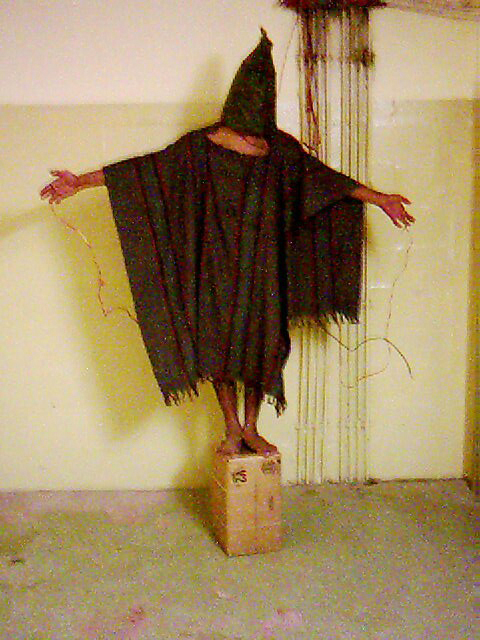What happened at Abu Ghraib and why did the US court award damages? | Human Rights Issues

A US judge has ruled that Virginia-based contractor CACI must pay $42m to three Iraqi men who were tortured at Abu Ghraib prison in 2004.
But what exactly was it and what happened there? What was the case about? Here’s what you need to know:
What was Abu Ghraib?
Abu Ghraib, a maximum security prison in Abu Ghraib, Iraq, was used by the US to “interrogate suspects” after the invasion of Iraq.
Established in the 1950s, it was used by former President Saddam Hussein to hold political prisoners during his presidency from 1979 to 2003.
After the US invaded Iraq in 2003, deposing Hussein who was later killed, Abu Ghraib was taken over by US forces.
In September 2006, Abu Ghraib was handed over to the Iraqis and in April 2014, it was closed.
Was there abuse and torture at Abu Ghraib?
Yes.
In 2003, pictures began to emerge of Iraqi detainees being tortured by American prison guards.
Like one of the captive prisoners attached to the electric wires, he was forced to stand on top of a small box.
He had been told that he would be electrocuted if he fell into the box.
The photo was of Ali Shallal al-Qaysi, who testified about it in 2005.
After he lost the use of his hand due to torture, the American security guards started calling him “Claw Man”.
Other images show prisoners forced into humiliating positions, sometimes smeared with feces, while US prison guards stand, smiling, beside them.
Are abusers doing anything?
The questions were introduced in 2004 by retired US Major General Antonio Taguba and retired US Major General George Fay. Another investigation was launched in 2008 by the US Senate Committee on Armed Services.
The interrogations revealed more about the abuses that took place at Abu Ghraib, including sexual assault, rape, and physical and mental torture and led to the death of at least one prisoner, Manadel al-Jamadi.
In the following years, 11 US soldiers were charged with dereliction of duty, torture, aggravated assault and battery. They were sentenced in military courts, nine were sentenced to imprisonment.

A civil lawsuit against CACI by four Iraqi prisoners who were tortured at Abu Ghraib was filed in 2008 by the New York-based non-profit Center for Constitutional Rights (CCR) representing the plaintiffs.
The indictment charged that CACI personnel were providing “investigative services” at Abu Ghraib.
What was the outcome of the US case?
A US federal judge on Tuesday ruled that CACI must pay three Iraqi plaintiffs – Suhail Al Shimari, Salah Al-Ejaili and Asa’ad Al-Zubae – $3m each in compensatory damages and $11 m each person for punitive damages.
A fourth plaintiff, Taha Yaseen Arraq Rashid, was removed from the case in 2019 because he was tortured before CACI was present at Abu Ghraib.
CACI signed a subcontract agreement with the US government in 2003, receiving more than $19m for “investigative services”.
The plaintiffs were released without being charged with a crime, according to the CCR.

Who are the complainers? What are they made of?
In November 2003, Al Jazeera Arabic cameraman Al-Ejaili was arrested by an American soldier while covering the attack on US forces in Diyala – and was detained for months.
“The worst was the first day I arrived at Abu Ghraib, the way they forced me to strip … naked in front of everyone,” Ejaili said.
“They put a black hat on my head and left me hanging all night,” he said, adding that the Americans sang “Happy birthday, Al Jazeera” to him as he hung there. He was released after two months.
Al Shimari was at Abu Ghraib from 2003 to 2008, during which time, he said, he was threatened with dogs, electrocuted and forced to take part in nude exercises.
Al-Zubae was held from 2003 to 2004, where he was tortured, including solitary confinement, anesthesia, and extreme hot and cold water.
What happened during the trial?
CACI tried to have the case dismissed more than 20 times. Here is a timeline of other events:
- June 30, 2008: CCR is filing a lawsuit in U.S. District Court in Ohio on behalf of the three plaintiffs and Rashid.
- August 2008: The case is being transferred to Virginia.
- February 27, 2019: Complainant Rashid was condemned because he was tortured before CACI personnel arrived at Abu Ghraib.
- April 15, 2024: The trial begins – for the first time the victims of torture at Abu Ghraib testify before a US judge.
- May 2, 2024: The jury fails to reach a unanimous decision, the jury declares not guilty.
- June 14, 2024: The judge grants the plaintiffs’ motion for a new trial.
- October 30, 2024: The retrial begins in federal court in Virginia.
- November 12, 2024: Judge finds CACI responsible for its role in torturing plaintiffs at Abu Ghraib.

Was this the only case of Abu Ghraib torture?
No.
In June 2004, the first petitions for action on behalf of 256 Iraqi civilians who were tortured at Abu Ghraib were filed by CCR and other counsel.
Lead plaintiff Haidar Saleh, a Swedish citizen, was arrested twice at Abu Ghraib – once by the Iraqi government before the US invasion of Iraq and the US military.
The defendants were CACI, US private contractor L-3 Services (formerly Titan Corporation), and Adel Nakhla, a former employee of Titan/L-3.
In June 2011, the US Supreme Court declined, without comment, to hear the case.
In June 2008, Wissam Al-Quraishi, along with 71 others who claimed to have been tortured at Abu Ghraib and other prisons filed a lawsuit against L-3 Services and Nakhla.
In October 2012, a settlement was reached in the case, the details of which have not been disclosed.
Source link


